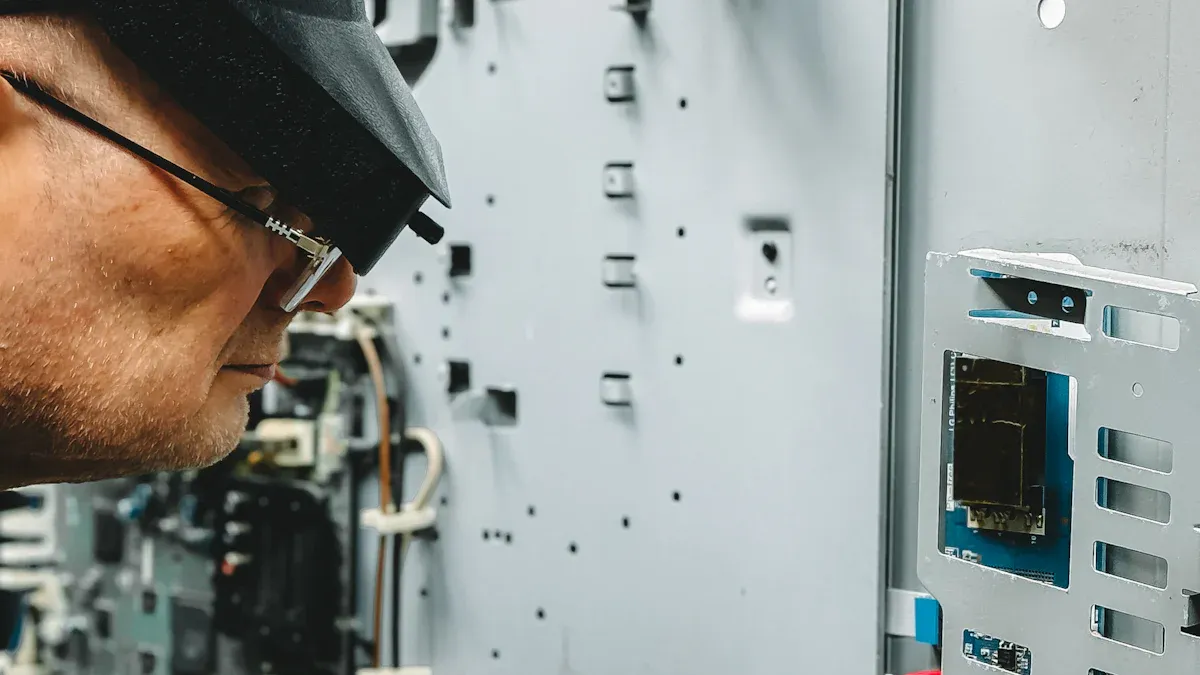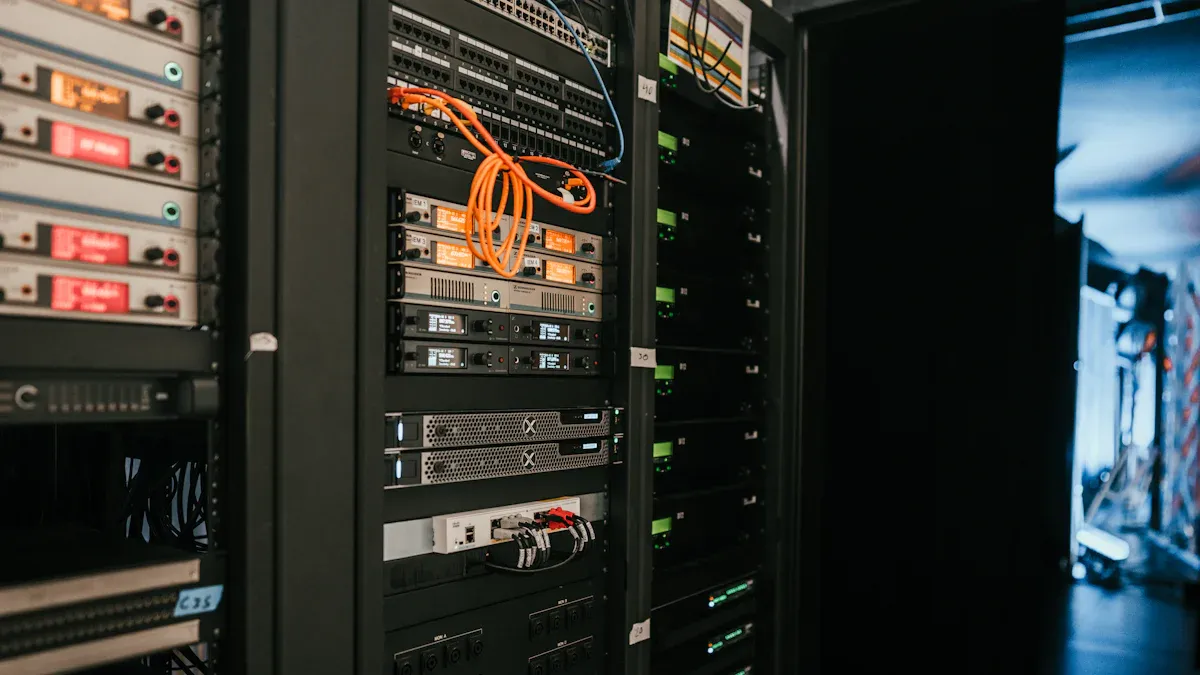Improving heat dissipation in rectifier module telecom cabinets to prevent efficiency drop in high-temperature environments

Effective heat management in your rectifier module keeps your telecom cabinet running smoothly. Poor heat dissipation leads to several issues:
Increased energy losses as heat, which raises cooling demands and operational costs.
Greater risk of thermal-related failures, more frequent maintenance, and reduced system uptime.
Higher internal temperatures that can shorten the lifespan of sensitive electronics.
You can use thermal evaluation tests, heat cameras, and sensors to check how well your system handles heat. Regular stress testing helps you spot weak points and ensures your equipment stays reliable, even in tough environments. Start by assessing your current setup and look for ways to improve both now and in the future.
Key Takeaways
Keep your telecom cabinet cool to save energy, prevent failures, and extend equipment life.
Regularly clean dust and filters, and check airflow to avoid overheating and maintain efficiency.
Use temperature sensors and monitor your system to catch heat problems early and act fast.
Choose the right cooling method—fans, natural airflow, modular heat sinks, or liquid cooling—based on your environment and equipment needs.
Design your cabinet layout to allow good airflow and separate hot and cold zones for better cooling performance.
Why Heat Dissipation Is Critical
Efficiency and Reliability
You need to manage heat effectively to keep your telecom cabinet running at peak performance. When you convert AC to DC, the process generates heat. If you do not remove this heat, your system loses efficiency and wastes energy. Cooling fans and heat sinks help maintain the right temperature, but you must keep them clean and free from dust. Dust buildup blocks airflow and reduces cooling power.
Tip: Place your equipment in a well-ventilated area and check airflow paths regularly. Good airflow prevents hot spots and keeps your system stable.
You can rely on forced cooling systems, such as fans, and insulation materials to prevent heat from radiating to sensitive parts. Many systems operate reliably from -20℃ to +55℃, even outdoors. Features like hot-swappable modules and N+1 redundancy let you perform maintenance without shutting down the system. High integration and advanced switching technologies also help reduce heat generation and energy use.
Key benefits of proper heat management:
Stable operation in extreme temperatures
Lower energy losses
Longer equipment lifespan
Fewer unexpected shutdowns
Overheating Risks
If you ignore heat buildup, you risk serious problems. Overheating can cause sudden shutdowns, reduced performance, and shorter equipment life. Poor ventilation, blocked air filters, and dust inside the cabinet often lead to these issues.
Common failure modes from poor heat dissipation:
MOSFET and power diode failures due to thermal stress
Thermal overload causing component degradation
Hot spots from improper mounting or bad thermal paste
Switching losses leading to thermal runaway
You should monitor temperature, clean dust, and respond quickly to alarms. If you do not address overheating, you may face system damage or even safety hazards. Regular maintenance and proper airflow keep your network reliable and safe.
Challenges in High-Temperature Environments

Ambient and Inlet Temperatures
You face unique challenges when your telecom cabinets operate in hot climates. High ambient temperatures, direct sunlight, and fluctuating weather conditions can quickly raise the internal temperature of your cabinet. You must monitor both the air around the cabinet and the temperature of the air entering it. These two factors directly affect how well your cooling systems work.
Note: The industry standard for safe operation ranges from -40°C to +65°C. Staying within this range helps you avoid efficiency loss and equipment damage.
Parameter | Description |
|---|---|
Ambient Temperature | Normal full load operation between -10℃ and 45℃; derating required from 45℃ to 65℃ |
Cooling Mode | Forced air cooling with built-in fan featuring linear speed regulation |
Altitude Effect | Maximum operating temperature decreases by 1℃ for every 200m increase above 3000m altitude |
Derating Behavior | Power output reduced at higher ambient temperatures to prevent overheating and ensure reliability |
If the air entering your cabinet is already warm, your cooling system must work harder. You may need to reduce the load on your equipment to prevent overheating. Intelligent ventilation systems help by drawing in cooler outside air and pushing out hot air. Always check that your cabinet is not exposed to direct sunlight or placed near other heat sources.
Load and Heat Sources
You must also consider the internal heat generated by your equipment. High power loads, dense component layouts, and multiple active devices all add to the heat inside the cabinet. The more devices you run, the more heat you must remove.
Environmental factors that make heat dissipation harder:
Direct sunlight exposure
High humidity and rain
Dust and airborne pollutants
Large daily and seasonal temperature swings
Solar heat-load variations
Insulation can help block external heat, while proper sealing keeps out dust and moisture. You should use cooling systems like air conditioners, fan cooling, or closed-loop air-to-air heat exchangers to manage internal temperatures. Regularly inspect your cabinet for dust buildup and check that all fans and filters work properly. By understanding your load and the sources of heat, you can adjust your cooling strategy and keep your equipment running safely.
Rectifier Module Maintenance
Cleaning and Monitoring
You need to keep your rectifier module and its surroundings clean to ensure proper heat dissipation. Dust and dirt can block airflow, causing your equipment to overheat. Use a soft cloth or compressed air to remove debris from the module and cabinet. Avoid using liquids, as moisture can damage sensitive electronics.
Schedule inspections of your telecom cabinets at least twice a year. After extreme weather, check for dust buildup or physical damage.
Clean ventilation systems and filters regularly. This helps maintain steady airflow and prevents hot spots.
Install temperature sensors inside your cabinet. These sensors alert you to rising temperatures before overheating becomes a problem.
Maintain a calendar to track inspection and cleaning dates. This ensures you never miss a maintenance session.
Tip: Proper mounting of your rectifier module prevents uneven placement and hot spots. Apply thermal paste designed for electrical systems to improve heat transfer between components.
A clean, dust-free, and moisture-controlled environment supports the long-term reliability of your rectifier module. You can also use dehumidifiers and cooling systems to manage heat and moisture more effectively.
Firmware Updates
You should not overlook firmware updates when maintaining your rectifier module. Manufacturers often release updates that improve thermal management and system stability. Updated firmware can optimize fan speeds, enhance temperature monitoring, and fix bugs that may cause overheating.
Check for firmware updates at least once a year or after major maintenance.
Follow the manufacturer's instructions to install updates safely.
Monitor your system after updating to ensure all features work as expected.
Keeping your firmware current helps your rectifier module operate efficiently, especially in high-temperature environments. Regular updates, combined with cleaning and monitoring, form a strong foundation for reliable heat dissipation.
Advanced Cooling Solutions

When you want to keep your telecom cabinet running efficiently in high-temperature environments, you need to consider advanced cooling solutions. These methods help you manage heat more effectively, protect your equipment, and reduce the risk of failure. Let’s explore three main options: modular heat sinks, liquid cooling, and fan or natural convection systems.
Modular Heat Sinks
You can use modular heat sinks to improve heat dissipation in your rectifier module. These heat sinks attach directly to the hottest components, drawing heat away and spreading it over a larger surface area. This process allows the heat to escape more easily into the surrounding air.
Here is a table that shows the key performance metrics of modular heat sinks used in telecom cabinets:
Performance Metric | Description and Impact on Modular Heat Sinks and Rectifier Modules |
|---|---|
Thermal Resistance | Reduced by solid copper clips in CFP packages, enhancing heat transfer and cooling efficiency |
Operating Temperature | Modules maintain thermal stability up to 175°C, ensuring reliability in high-density telecom environments |
Power Density | Achieves approximately 73 W/in³, enabling compact, high-density power delivery suitable for telecom cabinets |
Efficiency | Up to 99%, critical for energy savings and supporting demanding 5G/6G network loads |
Package Types | CFP3 and CFP5 reduce PCB space by 38% to 56%, improving thermal management by increasing surface area and lowering resistance |
Modularity and Scalability | Modular heat sinks and designs allow easy scaling and maintenance, supporting dynamic telecom infrastructure needs |
Thermal Management | Incorporates advanced materials, thermal vias, copper planes, and temperature sensors to optimize heat dissipation |
Integration | Compatible with Battery Energy Storage Systems and DC microgrids, facilitating flexible deployment in telecom cabinets |
Always balance electrical performance with thermal management. High-density computing and 5G networks require power systems that handle large loads and stay cool. Smart power distribution units with real-time monitoring and liquid cooling can help you manage these challenges.
You can select modular heat sinks that match your cabinet’s size and power needs. These heat sinks are easy to install and replace, making them ideal for growing networks. Many telecom operators use modular heat sinks to support high-density equipment and maintain efficiency.
Liquid Cooling
Liquid cooling offers a powerful way to remove heat from your rectifier module, especially in cabinets with high power density. This method uses a coolant that flows through pipes or plates attached to hot components. The liquid absorbs heat and carries it away from the equipment.
Feature | Description |
|---|---|
Thermal Resistance | Liquid cooling reduces thermal resistance compared to air cooling and optimized heatsinks. |
Operating Temperature | Enables operation at higher temperatures (up to 175°C), improving reliability and lifespan. |
Cooling Cost Reduction | Advanced liquid cooling design reduces cooling costs by approximately 22% over older models. |
Heat Transfer | Use of high-conductivity thermal interface materials enhances heat transfer efficiency. |
Failure Risk | Improved heat dissipation lowers overheating risk, reducing failure rates in telecom rectifiers. |
Power Density Support | Supports higher power density designs due to superior thermal management capabilities. |
Research shows that liquid cooling systems can precisely control the maximum temperature and temperature differences within a module. By adjusting the placement of cooling surfaces, the number of coolant inlets, and the flow direction, you can keep your equipment at safe temperatures with minimal variation. This level of control helps you prevent hot spots and extend the life of your telecom cabinet.
You may see higher upfront costs with liquid cooling, but you gain long-term savings by reducing equipment failures and maintenance. Many modern telecom sites use liquid cooling to support 5G and high-density installations.
Fan and Natural Convection
You can choose between passive (natural convection) and active (fan-assisted) cooling for your telecom cabinet. Each method has its own advantages and limitations.
Passive Cooling (Natural Convection):
Uses the natural movement of air to carry heat away from components.
Works best in mild climates and with low-power equipment.
Requires proper vent placement and unrestricted airflow.
Has low maintenance needs and no moving parts.
Active Cooling (Fan-Assisted):
Uses fans to force air through the cabinet, improving heat removal.
Handles higher heat loads and dense equipment layouts.
Allows you to target hot spots with fan trays or directed airflow.
Needs regular maintenance and careful positioning to avoid airflow problems.
Cooling Method | Advantages | Limitations |
|---|---|---|
Natural Convection | - Cost-effective and simple | - Limited cooling capacity |
Fan-Assisted Cooling | - Improves airflow and heat dissipation | - Higher cost and complexity |
Natural convection works well in shaded, ventilated outdoor areas with low-power equipment. Fan cooling is better for moderate to high heat loads, such as in urban data centers. In extreme environments, you may need advanced solutions like air conditioning or heat exchangers to maintain safe temperatures.
Real-World Examples
Natural Cooling in Rural Areas: You can install cabinets in shaded, ventilated spots to maintain stable temperatures without extra energy use. This method works well for low-power setups and reduces both noise and maintenance.
Fan Cooling in Urban Data Centers: Multiple fans can keep cabinet temperatures at 25°C even when the outside air reaches 35°C. This approach balances cost and performance.
Heat Exchangers in High-Density Sites: Air-to-air heat exchangers can keep internal temperatures within 5°F of ambient, cut energy use by 40%, and lower equipment failures.
Liquid Cooling for 5G Networks: Some telecom operators use liquid cooling to support high-density 5G equipment, reducing cooling costs by over 20% and improving reliability.
When you choose a cooling method, consider your climate, equipment density, and maintenance resources. You should also check for compliance with environmental standards like IP, NEMA, and GR-487, which set requirements for thermal performance and protection.
Upgrading to advanced cooling solutions may require higher initial investment, but you gain long-term savings by preventing equipment failures, reducing downtime, and lowering maintenance costs. Smart cooling systems with remote monitoring and AI can further improve efficiency and reliability.
Cabinet Design and Monitoring
Layout Optimization
You can improve heat dissipation in your telecom cabinet by optimizing the internal layout. Start by spacing racks and equipment to allow free air circulation. This prevents hot spots and helps cooling systems work efficiently. Use blanking panels to separate hot and cold air zones. This stops air from mixing and increases cooling effectiveness.
Place heavier or high-power devices near airflow sources, such as fans or vents. This ensures that cool air reaches the hottest components first.
Follow these steps to maximize airflow and cooling:
Avoid overcrowding racks. Leave enough space for air to move between devices.
Use perforated doors and built-in fans to enhance ventilation.
Keep cables neat and out of airflow paths with cable management modules.
Allocate space for accessories and sliding racks to prevent airflow blockage.
Regularly clean filters and vents to maintain steady airflow.
Some advanced cabinets use vortex tube technology. This system directs cold air to heat-generating parts, reducing internal temperatures and keeping dust out. Positive pressure inside the cabinet also helps block contaminants, protecting your rectifier module.
Temperature Sensors
You can use temperature sensors to monitor and control the internal environment of your cabinet. Place sensors near heat sources and cooling fans to detect hot spots quickly. Real-time monitoring lets you respond to rising temperatures before they cause problems.
Temperature sensors offer several benefits:
Predictive maintenance tools use sensor data to spot overheating early, reducing downtime and repair costs.
Integrated sensors save space and simplify design, making your system more reliable.
Remote monitoring allows you to track temperature and humidity, set alerts, and schedule preventive maintenance.
Cabinets with temperature sensors maintain stable conditions, extend equipment lifespan, and support continuous operation—even in harsh environments.
By combining smart layout and sensor integration, you create a telecom cabinet that keeps your rectifier module cool, efficient, and reliable.
You can boost telecom cabinet efficiency by following a few key steps:
Schedule regular maintenance, including filter cleaning and inspections, to keep cooling systems working well.
Use advanced cooling like air conditioners or heat exchangers for precise temperature control and longer equipment life.
Design cabinets with smart layouts and remote monitoring for easy upgrades and compliance with safety standards.
For more insights, check the technical note “Is It Time to Take a Serious Look at Convection Cooled Switched Mode Rectifier/Chargers Again?” by Eagle Eye Power Solutions.
FAQ
How often should you clean your telecom cabinet filters?
You should clean filters every three to six months. If your site faces dust, storms, or heavy use, check filters monthly. Clean filters keep airflow strong and prevent overheating.
What is the best way to monitor cabinet temperature?
Install digital temperature sensors near heat sources. Use remote monitoring systems to track readings. Set alerts for high temperatures. This helps you act before equipment overheats.
Can you upgrade cooling without replacing the whole cabinet?
Yes! You can add modular heat sinks, install extra fans, or use air-to-air heat exchangers. These upgrades improve cooling and fit most existing cabinets.
What should you do if your cabinet overheats?
First, check airflow paths and clean dust from vents. Lower the load if possible. Inspect fans and sensors for faults. If the problem continues, consider advanced cooling solutions or consult your equipment provider.
See Also
Exploring Various Cooling Techniques Used In Telecom Cabinets
Selecting The Ideal Cooling Solution For ESTEL Telecom Cabinets
Maintaining Perfect Temperature Control For Outdoor Telecom Cabinets
Guaranteeing Consistent Power Delivery Within Telecom Cabinets
Benefits Of ESTEL Cooling Systems For Industrial Cabinet Use
CALL US DIRECTLY
86-13752765943
3A-8, SHUIWAN 1979 SQUARE (PHASE II), NO.111, TAIZI ROAD,SHUIWAN COMMUNITY, ZHAOSHANG STREET, NANSHAN DISTRICT, SHENZHEN, GUANGDONG, CHINA

